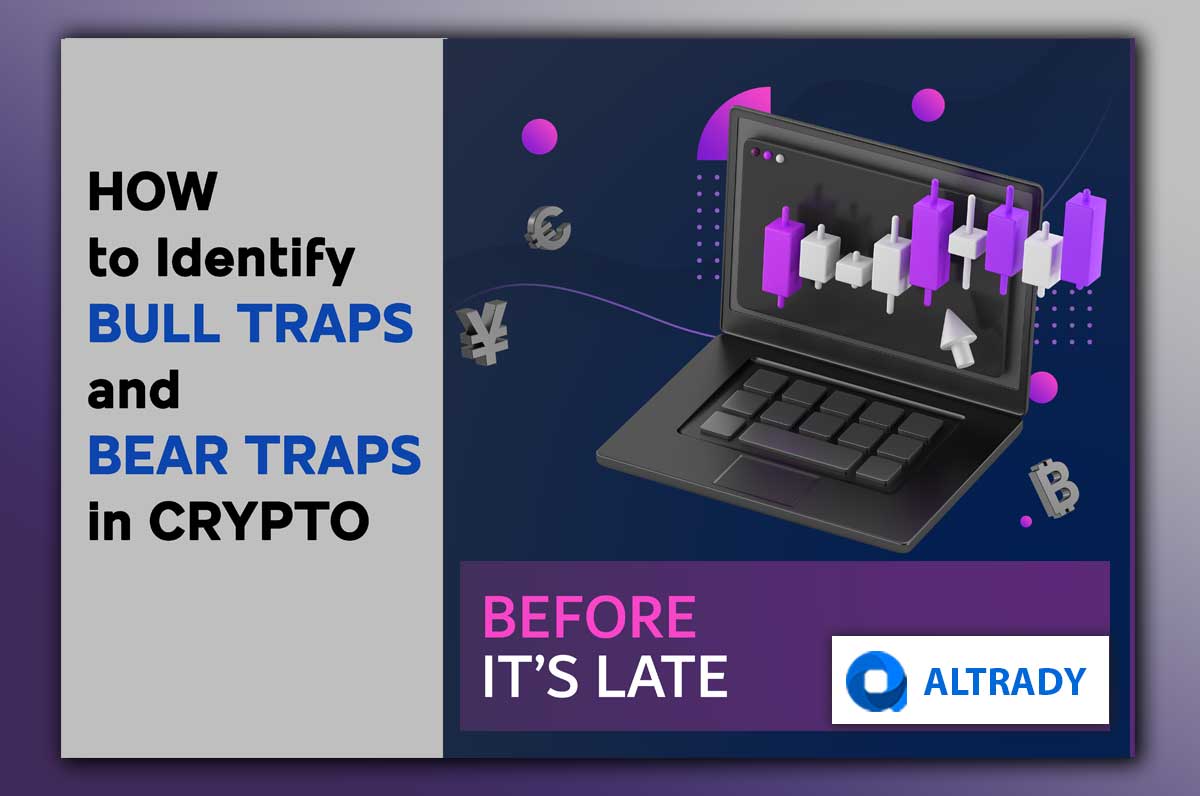Black Friday is loading…
Get 40% off with Altrady’s yearly plan and take the lead.
.svg)
.svg)
.svg)
.svg)
.svg)
.svg)
.svg)
.svg)
.svg)
.svg)
.svg)
.svg)
.svg)


Bull and bear traps are treacherous setups in crypto’s volatile markets, where whales, exchanges, and algorithms exploit retail traders’ FOMO and panic. A bull trap lures buyers into a fake breakout before a dump; a bear trap tricks sellers into a false breakdown before a rally.
Spotting these traps early can save your capital—and even let you profit from others’ mistakes.
Read more below about bull and bear traps, namely seven advanced techniques to identify them in crypto, and show how to use tools like VWAP, OBV, and on-chain data to stay ahead.
Whether trading Bitcoin or memecoins, these strategies will keep you in control.

Bull Trap: A fake upward breakout (e.g., above resistance) that lures buyers, followed by a sharp reversal, liquidating longs.
Bear Trap: A fake downward breakdown (e.g., below support) that induces sells or shorts, followed by a rally, liquidating shorts.
Crypto Context: Crypto’s 20% swings and whale-driven liquidity make traps frequent, especially in low-liquidity altcoins and DEXs.

Smart money (whales, exchanges, algorithms) engineer traps to:
Stay ahead of traps with these crypto-specific techniques:

Why It Works: Genuine breakouts have strong volume; traps lack follow-through, often showing OBV divergence.
How to Do It:
Crypto Tip: A Bitcoin bull trap often shows a volume spike with flat OBV, signaling whale manipulation.
Why It Works: Whales leave on-chain footprints, exposing traps.
How to Do It:
Crypto Tip: Bear traps in Ethereum often follow whale outflows with no on-chain sell pressure.

Why It Works: VWAP reveals institutional pricing, exposing overextended moves.
How to Do It:
Crypto Tip: Altcoin bull traps often break resistance far above VWAP, signaling reversal.
Why It Works: DEXs (e.g., Uniswap) have thin liquidity, amplifying trap setups.
How to Do It:
Crypto Tip: Memecoin bear traps in $500K pools often reverse with Volume spikes.
Why It Works: News (e.g., regulatory updates) triggers fake breakouts, trapping FOMO traders.
How to Do It:
Crypto Tip: Bitcoin bull traps during ETF news often lack on-chain buy support.
Why It Works: Algorithms target stop-loss clusters, creating traps.
How to Do It:
Crypto Tip: Bear traps in futures often sweep lows with Volume spikes.
Why It Works: Journaling builds pattern recognition for traps in crypto’s chaos.
How to Do It:
Crypto Tip: Use Altrady’s paper trading to test trap avoidance risk-free.
Outsmart traps with this crypto-specific approach:
Trap avoidance has pitfalls:
Crypto Risks: Flash crashes, low-liquidity altcoins, and exchange glitches can mask traps. Use strict risk management (1-2% per trade).
Mitigation: Test in paper trading, use multiple confirmations (OBV, Ichimoku), and monitor on-chain/sentiment data.
Q: Are traps more common in altcoins?
A: Yes, due to low liquidity. Use OBV and on-chain data to filter traps in SOL, ADA.
Q: How do I trade post-trap moves?
A: Wait for reversals with Volume and Ichimoku confirmation. Enter at Fibonacci pullbacks.
Q: Can bots detect traps?
A: Partially. Program bots with VWAP and Volume rules, but manual oversight is key.
Q: How do I spot DEX traps?
A: Check pool size (DeFi Llama) and Volume. Avoid $500K or smaller pools.
Bull and bear traps are smart money’s traps, exploiting retail FOMO and panic in crypto’s wild markets. By mastering techniques like volume analysis, on-chain signals, and VWAP, you can spot traps early and trade with confidence.
These seven strategies—volume, on-chain, VWAP, DEX, news, stop hunts, and journaling—are your edge.
Start small, practice on platforms like Altrady, and journal every trade. Trap avoidance isn’t about catching every move—it’s about outsmarting the market’s trickiest setups.
Disclaimer: This article is for educational purposes only and does not constitute financial advice. Cryptocurrency trading is highly volatile and risky. Always do your own research and consult a financial advisor before making any financial decisions.